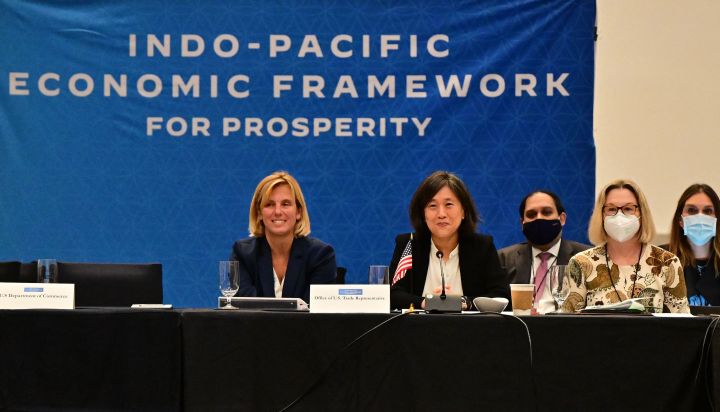
A different kind of trade agreement

The Joe Biden administration and representatives from 13 countries around the Pacific wrapped up economic talks in Los Angeles last week. They’re putting together something called the Indo-Pacific Economic Framework. It is kind of like a trade agreement, just light on the whole trading of goods thing.
The U.S. sat down with countries that include South Korea, Japan, India and Australia — a cohort that represents 40% of the world’s GDP. They talked about labor standards, supply chains, climate change, corruption. Not much talked about? Tariffs.
“This is a trade agreement that is not a trade agreement,” said James Bacchus at the University of Central Florida, who used to head the World Trade Organization’s top panel for arbitrating trade disputes. “The U.S. is not even offering to talk about tariffs.”
For Bacchus that’s a downside, but the Biden administration is calculating that trade agreements involving a lot of tariff reductions won’t fly in Congress.
“The challenge with trade agreements is that it is economically efficient, but it does create winners and losers,” said Renee Bowen, a professor of economics at the University of California, San Diego.
The administration promised a laborcentric trade policy, and that would appear to mean avoiding an agreement full of tariff reductions that could harm some workers. Which is why the IPEF, as it’s called, includes discussion of labor standards.
“At the same time, they are not really compromising on wanting to expand trade in digital services,” Bowen said.
Agreements that would help U.S. digital services reach new markets could be a big win for U.S. businesses.
“A digital trade agreement could increase U.S. economic output by $72 billion over the first three years,” said Jake Colvin, president of the National Foreign Trade Council.
Absent from these trade talks is China. The Indo-Pacific Economic Framework is talked about as a way to counter China’s influence in the region. How that will play out is as unclear as ever.
There’s a lot happening in the world. Through it all, Marketplace is here for you.
You rely on Marketplace to break down the world’s events and tell you how it affects you in a fact-based, approachable way. We rely on your financial support to keep making that possible.
Your donation today powers the independent journalism that you rely on. For just $5/month, you can help sustain Marketplace so we can keep reporting on the things that matter to you.











